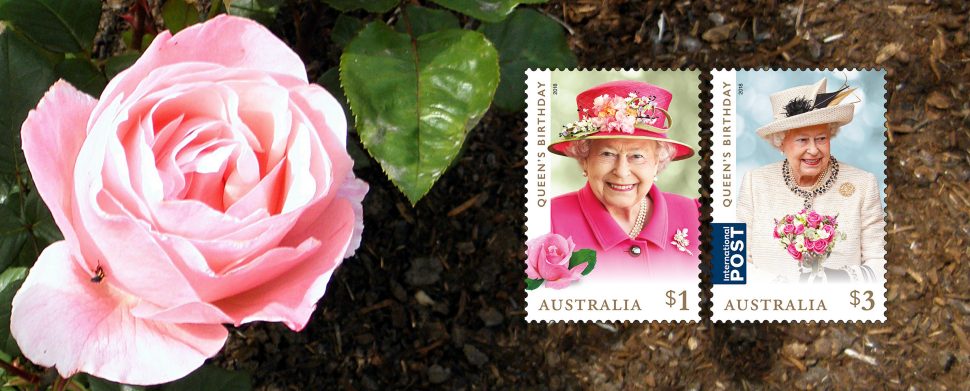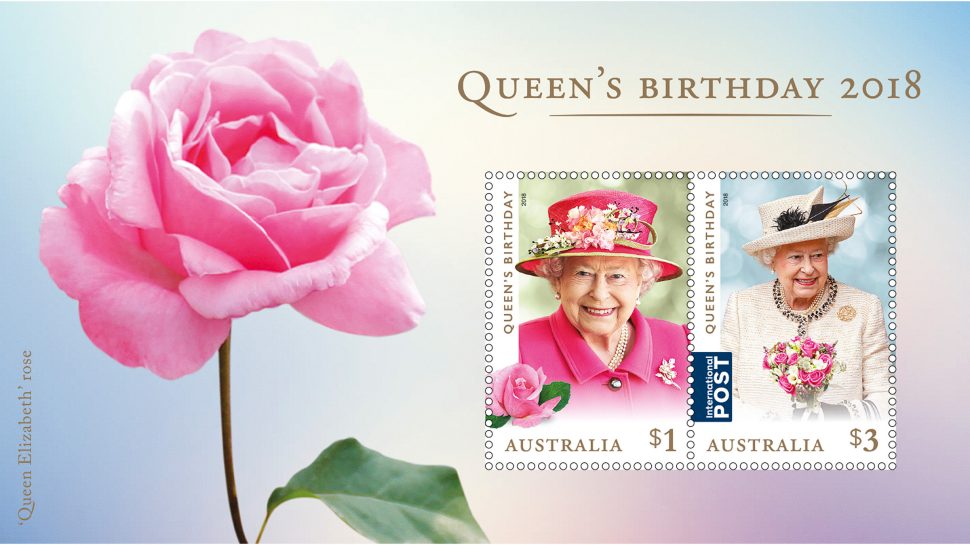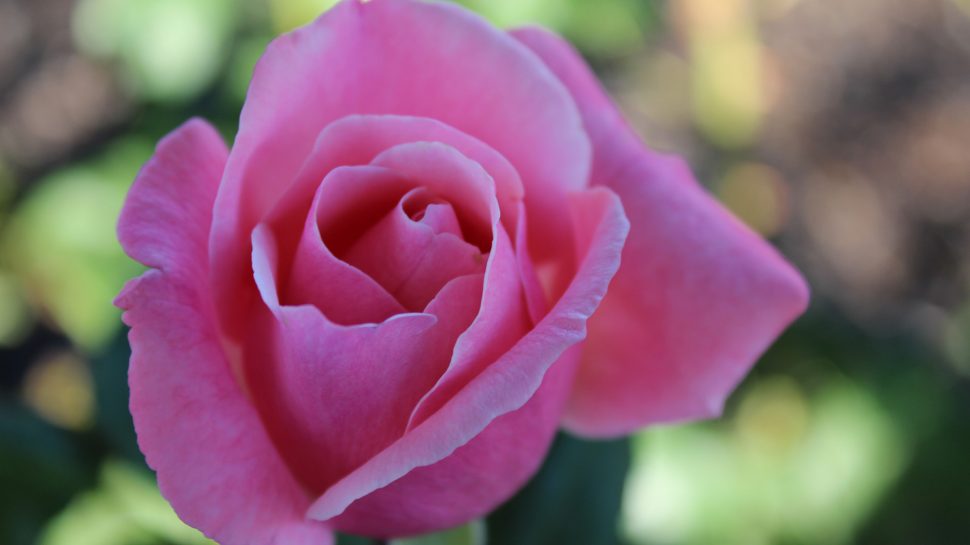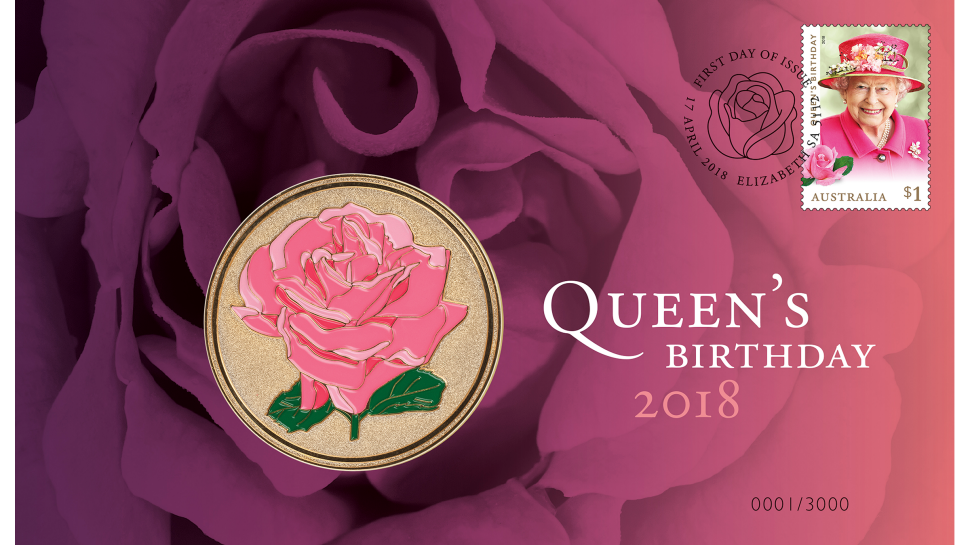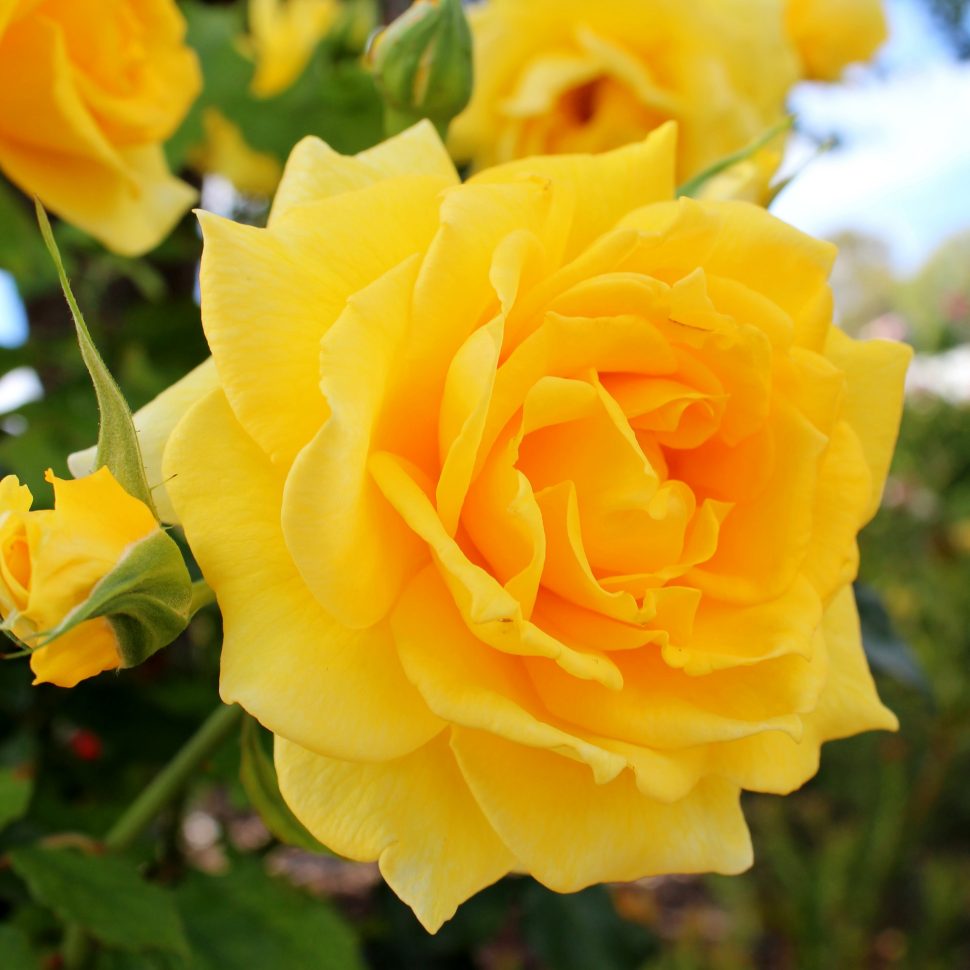This year’s Queen’s Birthday stamps, released on 17 April 2018, feature a floral theme, with a particular focus on the Queen Elizabeth rose. The ‘Queen Elizabeth’ was released in 1954 to honour Her Majesty the Queen’s ascension to the British throne in 1952 and subsequent coronation in 1953.
Bred by Dr Walter Lammerts in the USA, the Queen Elizabeth rose has large medium-pink blooms with up to 40 petals. Its long stems are ideal for cutting, and it has an extensive bloom period from summer through to autumn. This elegant and mildly fragrant rose, with dark green leathery leaves, grows to around three metres high and one metre wide; several plants can be trained to form an attractive hedge.
The Queen Elizabeth rose is also a multi-award winner. It was named as the Gold Rose of The Hague 1968 and as an inductee into the World Rose Hall of Fame in 1979. Its parent roses, ‘Charlotte Armstrong’ and ‘Floradora’, are multi-award winners too, and the ‘Queen Elizabeth’ has been used to develop 19 other impressive rose varieties, including ‘Princess Margaret’, named in honour of the Queen’s sister. The Queen Elizabeth rose is central to the design of the Centenary Rose brooch, presented by the Queen to the Queen Mother in 2000 as a 100th birthday gift.
The Queen Elizabeth rose is also the theme of the medallion cover released with the stamp issue. The cover, limited to 3,000, contains a specially designed 60-millimetre polished gold medallion that features a rendition of the ‘Queen Elizabeth’.
Of much assistance to the researcher on the Queen’s Birthday 2018 stamp issue were rose experts Kelvin and Melanie Trimper. We spoke to Kelvin about his love for roses and why the Queen Elizabeth rose is so special.
Kelvin Trimper AM isn’t just a rose enthusiast, he’s a virtual ‘king of roses’ in both Australian and international rose circles. He’s President of the World Federation of Rose Societies, which was established in 1968 and includes 40 member countries. He is also a past President of the National Rose Society of Australia and the Rose Society of South Australia. Kelvin has been a member of the Rose Society of South Australia since 1975 and was honoured with Life Membership in 2012. He received the Australian Rose Award in 2012 and T.A. Stewart Memorial Award in 2013 for services to the rose in Australia and New Zealand. Kelvin has also served as Chairman of the National Rose Trial Garden of Australia for the past 17 years. Since 1999, Kelvin has lectured at many rose conventions all over the world. Excitingly for Australian rose enthusiasts, The National Rose Society of Australia will host the 2021 WFRS World Rose Convention in Adelaide in October 2021, and Kelvin currently chairs the 2021 Convention Committee.
Kelvin as born and raised in the rural town of Renmark in South Australia and this is where he developed a love for plants, especially roses, fruit trees and vegetables.
“The rose is the most popular flower in the world and is known as the Queen of flowers. I have seen people cry over roses at weddings and funerals and roses are very significant in many different cultures,” says Kelvin.
“My parents had a rose garden of about 500 roses so I started at an early age. Roses are a favourite choice for the garden because they are easy to grow and maintenance is relatively simple,” said Kelvin.
“I love the classic beautiful flowers, many renowned for their superb strong perfume and when combined with their repeat flowering ability (for approximately eight months during the growing season), improved disease resistance and wide range of colours, roses are very rewarding to grow and enjoy.”
Kelvin is certainly a fan of the Queen Elizabeth rose, as featured on the domestic-rate Queen’s Birthday 2018 stamp.
“Some really great roses are timeless. A good example is the classic Hybrid Tea rose ‘Queen Elizabeth’ also known as ‘Queen of England’. It is one of the world’s most popular roses and has won many awards worldwide,” says Kelvin.
“The Queen Elizabeth rose is tall and upright and features attractive pink blooms on long straight stems. The elegant buds of darker pink open to moderately fragrant, classic shaped blooms. The bush is very disease resistant and almost thornless with dark green, healthy foliage. I have enjoyed growing this rose for over 30 years,” says Kelvin.
Kelvin’s favourite rose, however, is ‘Gold Bunny’.
“In my garden, it hardly ever stops flowering and the bright yellow colour is very cheerful. ‘Gold Bunny’ is one of the earliest roses to flower in spring and keeps blooming until early winter. Soft gold in colour with a classic rose shape and light fragrance, the bush is neat and compact with bright lime green foliage and good disease resistance. A highlight is its ability to perform well in our hot, dry summers. ‘Gold Bunny’ can be grown as a hedge or in a mass planting and also makes an excellent standard rose on a one-metre stem,” says Kelvin.
Kelvin Trimper’s top tips for growing roses
Preparing the rose bed
- Roses like sun – at least six hours per day.
- Avoid competition from trees and shrubs.
- Soil should be enhanced with Neutrog’s Seamungus (a soil conditioner), GoGo Juice and compost. Clay soil will need gypsum.
Planting
- Dig a square hole 30cm x 30cm x 30cm, use 100 grams of Seamungus in base of hole.
- Roses should be spaced appropriately (Hybrid Teas and Shrub Roses: 1.3 to 1.5 metres apart; Floribunda, Patio and Ground Covers: 1 metre; Miniatures: half a metre).
- Bud union (where rose is budded) must be around 3 centimetres above ground level.
- Roots should fan out on mound of soil at the bottom of the hole.
- Backfill with soil until hole is half full and give bucketful of water.
- When water drains away, fill balance of hole.
Rose growing
- Apply fertiliser and preventative black spot and mildew sprays in spring, when growth first appears and immediately after first flowering.
- Prune roses in July. Plant new bare-root roses.
- Mulch late in winter while it is easy to move between roses.
- Water regularly during summer – one good soak every 5 to 7 days.
- Lightly trim roses in February and then apply fertiliser.
- Order new roses in autumn and prepare new rose beds in April. Most catalogues come out in April, too.
- Remove old roses in April and enhance soil with soil conditioner, mulch, compost and fresh soil.
For further local rose advice, Kelvin recommends consulting your State Rose Society. Details are available on The National Rose Society of Australia website.
The Queen's Birthday 2018 stamp issue is available from 17 April 2018, online, at participating Post Offices and via mail order on 1800 331 794, while stocks last.
View the gallery and technical details from this issue
Banner image by HomeinSalem [CC BY-SA 3.0 (https://creativecommons.org/licenses/by-sa/3.0) or GFDL (http://www.gnu.org/copyleft/fdl.html)], from Wikimedia Commons
This article was produced at the time of publication and will not be updated.
